Best walks in Dartmoor National Park
Penned on the 21st August 2023
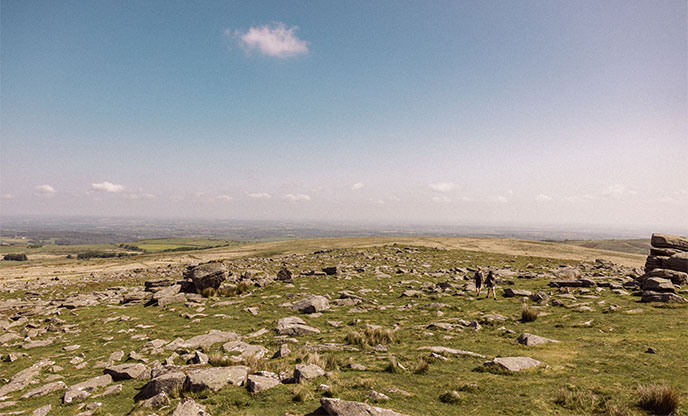
Spanning some 386 miles across the heart of Devon, Dartmoor National Park’s enchanting wild landscapes have been luring outdoor-enthusiasts ever since its designation back in 1951. Dartmoor is famed for its vast moorlands, rugged granite tors, roaming ponies and rich folklore – and, of course, it’s a heavenly destination for hikers. Whether you’re seeking a gentle stroll or a challenging full-day trek, there are a huge array of fantastic footpath networks to choose from (some of which include a traditional pub for a hearty post-walk meal or a charming tearoom for an indulgent clotted cream tea!). For this blog we’ve picked out some of our favourite routes with a mix of terrains, distances, landscapes and legends.
Fingle Bridge & Castle Drogo
Difficulty: Moderate
Distance: 4 miles
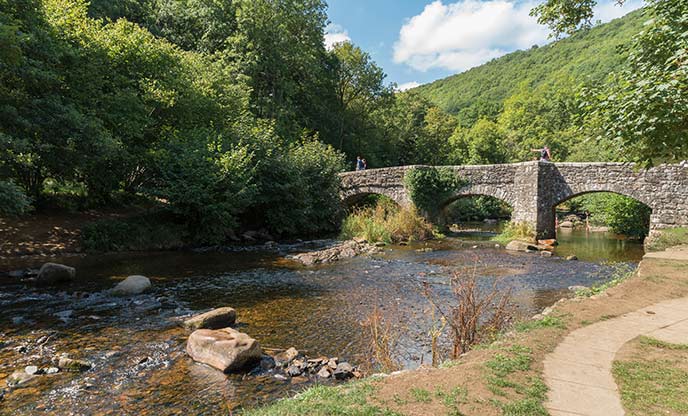
Perhaps one of the most famous walks in Dartmoor National Park, this stunning route takes you through Teign Gorge with breathtaking views over the wooded valley and winding River Teign. The route starts and ends at the picture-perfect Fingle Bridge Inn, a gorgeous spot for a pub lunch or refreshments at the end of your walk. There’s a steep ascent up to the Hunter’s Path at top of the gorge – it’s well worth the climb for the views, especially in autumn when the treetops turn the valley into a dazzling display of red and gold.
The well-trodden paths will lead you to Castle Drogo, the last castle to be built in England, now a National Trust property. You might want to allow a little time to explore the dramatic architecture and surrounding gardens before circling back to Fingle Bridge.
Wistman’s Wood
Difficulty: Easy to moderate
Distance: 2.8 miles
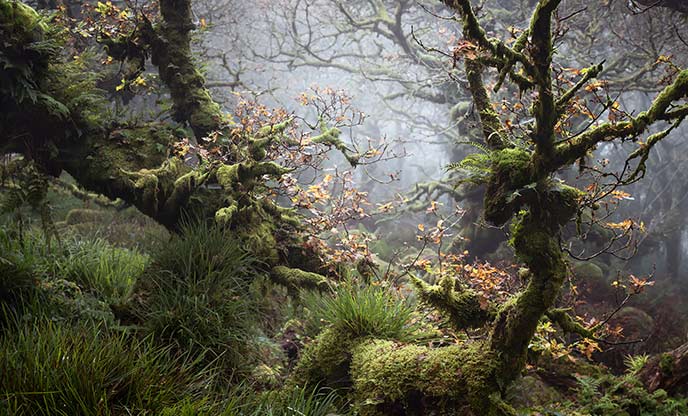
This circular route takes you on a magical walk around a tangled cluster of ancient dwarf oak trees with twisted branches covered in beautiful lichen and moss, like something from a fairytale. The woodland is thought to be over 6000 years old and like many places in Dartmoor it’s steeped in legend – it’s said that druids planted the trees, hence the name Wistman’s deriving from ‘wise man’ (another name for a druid).
The waymarked route starts and ends in the Two Bridges Car Park. Be sure to follow the path around the woodland rather than entering it, because the area is under pressure from erosion and it’s important not to disrupt this extremely rare and delicate habitat.
Hound Tor
Difficulty: Easy
Distance: 0.6 miles
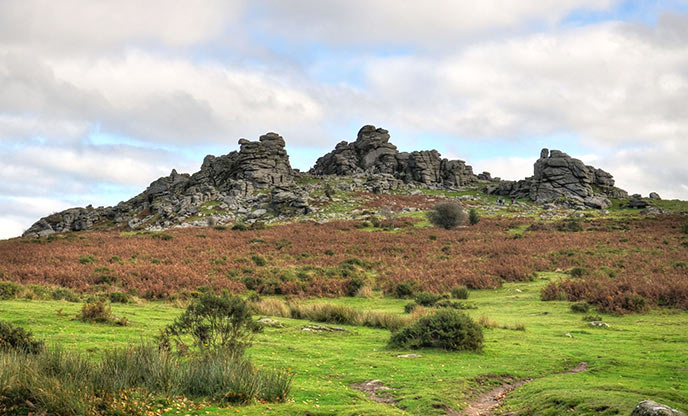
Hound Tor provides a quick and easy adventure for all ages and abilities, with one of the most expansive viewpoints in Dartmoor just a short walk from the car park. The grassy trail leads you on a steady climb alongside scattered boulders to the summit of the Tor. From this weathered rocky outcrop you can soak up awe-inspiring 360 degree views of the National Park.
Hound Tor is one of the most famous attractions on Dartmoor, not just for its beauty but for its legend and history too. The story goes that it was created when a hunter interrupted a coven of witches with his pack of hounds and the witches responded by turning him and the dogs to stone – and it’s reportedly the site that inspired Arthur Conan Doyle’s Hound of the Baskervilles. You can also visit the fascinating remains of a mediaeval village nearby that was thought to have been deserted in the 15th Century, just a short detour from the Tor before you head back to the car park.
Bellever Forest
Difficulty: Moderate
Distance: 2.5 miles
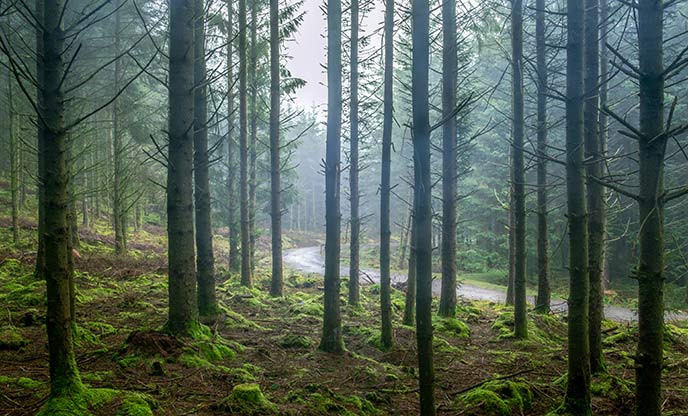
Bellever Forest near Postbridge is a hidden gem in the National Park. It’s a tranquil setting for a walk near the River Dart, with native Dartmoor ponies roaming wild and grazing amongst the towering coniferous trees. There are multiple waymarked walking routes to choose from here, from short easy access trails to longer distance challenging hikes. The Bellever Trail is a good all-rounder, meandering the forest past historic hut circles before heading out up to the striking rock stacks at Bellever Tor, where you’ll be rewarded with scenic views of the surrounding landscape.
There’s a lovely little picnic area in the forest too, so why not bring a packed lunch and savour a few peaceful hours in the woodlands when you’ve finished your walk?
Great Staple Tor & White Tor
Difficulty: Moderate to challenging
Distance: 6.4 miles
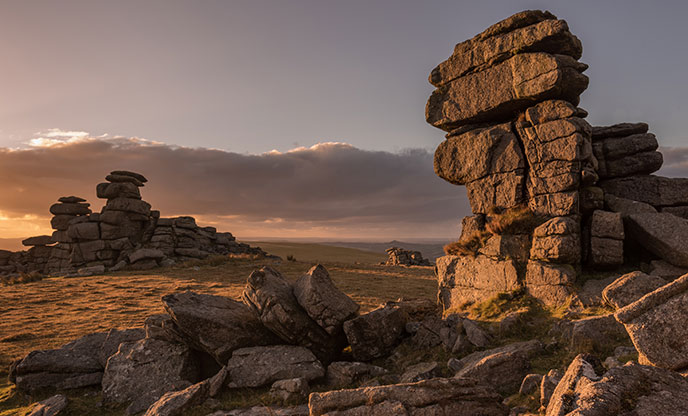
This moderately challenging 6.4 mile circuit heads along the impressive rocky towers of Great Staple Tor before leading to the magnificent White (pronounced ‘Whit’) Tor. From here you’ll get another excellent vantage point, with spectacular views over the Tavy Valley and all the way across to the sea in Plymouth and Bodmin Moor in the neighbouring county of Cornwall. And it’s not just the views that make this worth the trek – this is one of the most significant historic sites in Dartmoor and along the way you’ll encounter prehistoric stone circles that elude to the area’s fascinating past. They’re thought to be bronze age hillforts or possibly the remains of neolithic structures. Either way they’re over 3000 years old – and the mystery only adds to the sense of wonder!
Just a mile away from the car park where the White Tor walk begins and ends you’ll find the Eversfield Organic Dartmoor Inn, where you can rest your tired legs and refuel with a wholesome lunch and a locally brewed tipple.
Lydford Gorge
Difficulty: Easy
Distance: 2.6 miles

This short but popular walk follows the river and green ravine at Lydford Gorge, the deepest river gorge in the south west, formed naturally in the hills over thousands of years. The trail is lined with trees and mossy rock faces and leads to the rumbling Devil’s Couldron whirlpool and the spectacular 30 metre Whitelady Waterfall. This dramatic cascade gets its name from a local legend that says it’s home to a ghostly lady in a long white gown. Ghost or not, this place is breathtakingly beautiful so you’ll definitely want to pack a camera!
Despite being a fairly easy route, all of the water here means it can be extra slippery in places so sturdy walking boots are essential. If you’re with children or anyone who’d prefer an easier access route, there’s also an upper path that you can take instead.
High Willhays & Yes Tor
Distance: 8.5 miles
Difficulty: Moderate to challenging
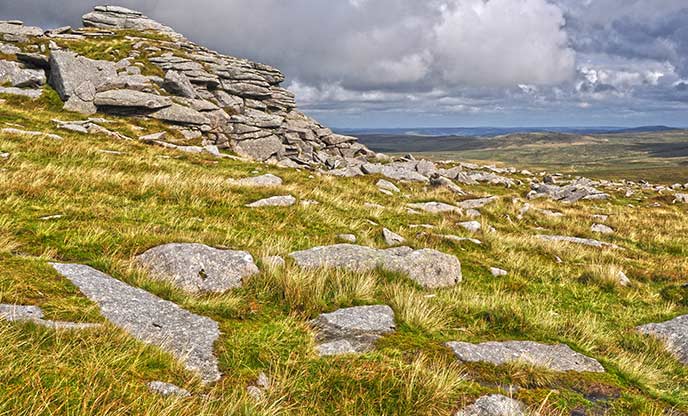
This rugged area in the north of the National Park makes for a wonderful day-walk (providing the military aren’t training. It’s a common zone for it so make sure you check the firing times on gov.uk before you set off). The route starts and finishes at Okehampton Station and takes you all the way to Dartmoor’s highest point High Willhays at 621 metres (2039 feet) above sea level, followed by the charmingly named Yes Tor, the second highest point. As you’d expect, the climb delivers some exceptional views of the moor and all the way across to Exmoor in Mid Devon and Cornwall to the west.
There’s no definitive path on this route and when the weather’s wet the ground can be particularly boggy and uneven, so make sure you’re prepared for some map and compass navigation if you decide to undertake this adventure!
Becky Falls
Difficulty: Easy, moderate or challenging (take your pick!)
Distance: varied
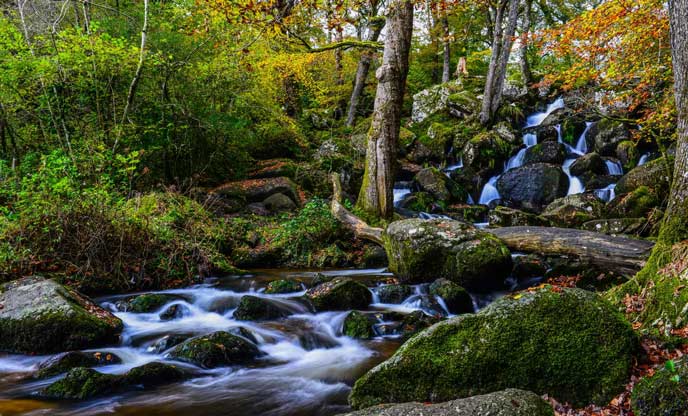
Set in a magnificent ancient valley, Becky Falls is a popular visitor attraction in Dartmoor and a lovely place to enjoy a walk, with over 50 acres of woodland, waterfalls and wildlife to discover. The park has three different walking trails to choose from, depending on who’s in your group or how much of a challenge you fancy. The Blue Trail is reasonably flat and features the children’s nature trail. The Red Trail is more demanding with some rocky ascents and scrambles – but it’s where you’ll discover the main falls, an impressive 70 foot cascade. And the most challenging Purple Trail is the ‘only for the fit and well shod’, according to the Becky Falls website!
Whichever route you choose, the on-site Woodland Café will be a welcome pitstop to rest and refuel with coffee and cake or a tasty burger. Or if you’d prefer to pack your own lunch there’s a designated picnic area too.
Wray Valley Trail
Difficulty: Moderate
Distance: 7 miles

The Wray Valley Trail on the fringes of Dartmoor follows the disused Newton Abbot to Moretonhampstead railway line, built by the Victorians back in 1866. The line was closed in 1959 but you’ll still get a great sense of the journey on-foot nowadays (just note that the trail is shared with cyclists and horse-riders too).
You can start your route at either Moretonhampstead or Bovey Tracey – either way you’ll travel through the beautiful National Trust Parke estate and the picture-postcard village of Lustleigh. Be sure to stop for an indulgent cream tea at the quaint, thatched-roofed Primrose Tearooms whilst you’re in the village. You’ll get the traditional full ‘china service’ if you sit in, or if the weather’s nice you can get a takeaway to enjoy in their lovely garden.
Burrator Reservoir
Difficulty: Easy
Distance: 3.9 miles
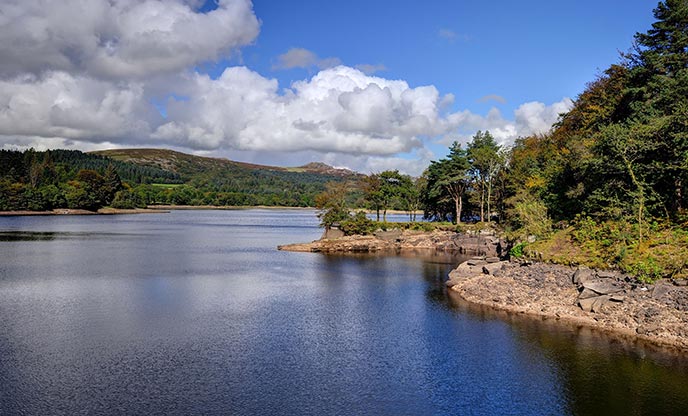
This gentle walk takes you on a circular route around the beautiful Burrator Reservoir in Yelverton in the southwest corner of the National Park. Burrator is one of Devon’s few lakes – and its tranquil waters and surrounding woodland make for a picturesque backdrop for your walk. It was built in 1898 to supply drinking water to Plymouth and other nearby towns and, in more recent years was featured in Steven Spielberg’s movie War Horse.
The pathway here is well-maintained and relatively flat so it’s a great choice for families looking for a day out in Dartmoor’s great outdoors. Walking across two huge dams enroute will only add to the little ones’ sense of adventure. Plus there’s often an ice cream van parked midway round the trail, so you can all enjoy a short stop for a welcomed sweet treat.
Drake’s Trail
Difficulty: Moderate to challenging
Distance: 14.9 miles
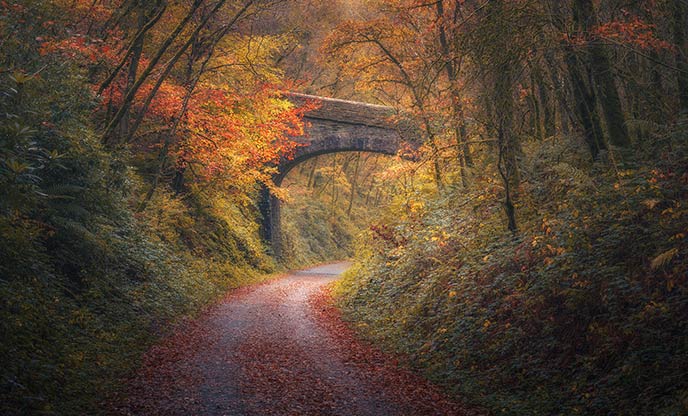
For those seeking a longer distance stomp and a full day out, Drake’s Trail could be the perfect choice. This cycle and walking route has plenty of variety, taking in picturesque countryside, several villages and towns, stunning viaducts and the atmospheric forests that surround Dewerstone Rock. The trail begins just outside of the Dartmoor in Plympton, before then heading along the western edge of the National Park all the way up to Tavistock.
Whilst the distance is long, the terrain isn’t overly difficult so it’s generally suitable for intermediate walkers with good stamina and a solid pair of well-worn boots. Just note that this route and distance is one-way, so you’ll need to arrange transport to get back!
Preparing for your adventure in Dartmoor

Wherever you choose to set off by foot, make sure you do so safely – this is the wilderness after all! Dartmoor’s weather is notoriously fickle so you might have sun, rain, hail and fog all on the same day, so be prepared. The military uses parts of the national park for live firing practice too, so make sure you don’t enter areas where red flags are flying. It’s also very easy to get lost here so be sure to carry a map and compass, especially if you’re navigating one of the routes less-travelled.
Staying in Dartmoor
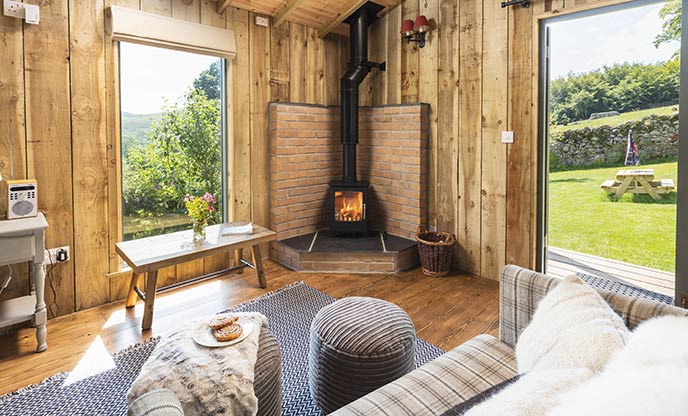
If you’re looking for a beautiful base for a magical walking holiday in Dartmoor, take a look at our hand-picked collection of unique glamping sites in the area. Room With A View is right in the heart of the National Park, so could be a perfect choice. This gorgeous wooden cabin is set on a peaceful farm and overlooks Haytor (near to the Hound Tor walk mentioned above). Or if a shepherd’s hut is more your cup of tea you’ll love Nellie’s Nook, a romantic countryside haven just north west of Tavistock.
We have a whole host of beautiful choices in the surrounding Devon countryside too. You can find our full list of hideaways in Devon here.